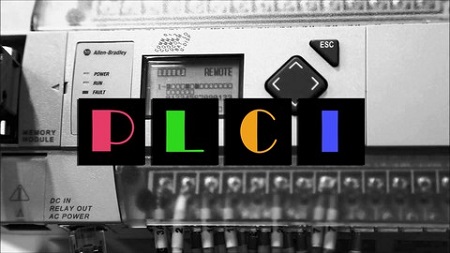
English | MP4 | AVC 1280×720 | AAC 48KHz 2ch | 10 Hours | 1.22 GB
This course will give a person with no prior experience the basic tools necessary to create a PLC program from scratch.
This course is designed to equip the novice with no prior PLC programming experience with the basic tools necessary to create a complete PLC program using ladder logic common to most current platforms.
Using the Rockwell software RSLogix 500 and FactoryTalk View Studio, we will be covering such topics as general controls, digital and analog IO, ladder logic programming, alarm / notification handling, HMI, emulation, best practices and more.
In the end, we will go through an entire, working PLC program and HMI line by line to solidify comprehension of the learning objectives.
Why Are There Four PLC Courses?
PLC I teaches you how to program with the focus on ladder logic, which is the most popular PLC programming language. The goal is to teach you everything you need to know to make a PLC do what you want it to do. You are also given all the software necessary to both CREATE and RUN your own programs live – right on your own computer.
PLC II forces you to take what you’ve learned and solve problem after progressively harder problem unassisted. You get a spec and are told simply: “Make it work, and don’t progress until you have.” After, you get to watch me solve each one as well. By the end, you don’t just know how to program – you are a PROGRAMMER.
PLC III gives you both knowledge and experience in FIVE different HMI / SCADA development environments. By the end, you’ve created several COMPLETE visualization (screen) projects that you can actually run on your own computer (and SHOW PEOPLE in an interview) with no additional hardware.
PLC IV is only for the heavyweights. This course teaches you how to program using all five IEC programming languages (plus one more) in multiple environments. There are projects as well, so by the end, you have seen it all and DONE it all as well. There won’t be anything anybody can show you that you won’t already be familiar with.
What Will I Learn?
- By the end of this course, you will be able to create a PLC program from scratch.
- The primary and overall objective of this course is to give a novice an understanding of PLC programming, ladder logic, and the inner workings of a standard HMI (Human-Machine Interface).
- Students will learn the difference between digital and analog signals and how to bring them into a PLC, process them, and send them back out.
- Students will be familiarized enough with a sufficient variety of ladder logic instructions to create a complete PLC program from scratch.
- Students will explore basic, standard controls techniques for things like HOA control, level control, pump control, and (on at least an introductory level) PID control loops.
- Students will develop an understanding of alarm and notification programming, and the relevant considerations to safety and operator usability.
- Students will be introduced to HMI development and given a general understanding of how an HMI program
Table of Contents
Introduction
1 Course Intro_ Curriculum _ Objectives
2 Software and Course Notes
3 Contacting Your Instructor
PLC Programming Overview
4 Section Objectives
5 PLC Automation
6 RSLogix 500 Environment
7 Basic Functionality of a Program (Inputs_ Outputs_ Conversion)
8 Section Wrap-up
IO (Inputs and Outputs)
9 Section Objectives
10 IO Overview
11 Digital IO
12 Analog IO
13 IO Modules
14 Section Wrap-up
Programming Fundamentals
15 Section Objectives
16 Data Management
17 A Bit More on Addresses
18 Rungs and Branches
19 Conditions and Outputs (Left to Right)
20 XIO_ XIC_ OTE
21 OTL_ OTU
22 ONS_ OSR_ OSF
23 TON_ TOF_ RTO
24 CTU_ RES
25 Comparators
26 Mathematical Operators_ CPT
27 SCP
28 A Bit More on Analog Scaling
29 MOV
30 JMP_ LBL
31 PID (Proportional Integral Derivative) Control Loops
32 Section Wrap-up
Program Setup
33 Section Objectives
34 Setup Program _ Processor
35 Module Configurations
36 Scaling _ Resolution
37 Function Files
38 Program Files
39 Section Wrap-up
IO Programming
40 Section Objectives
41 Programming Digital IO
42 A Bit More on Digital Control Logic
43 Programming Analog IO
44 Analog Process Control (LL_ L_ H_ HH)
45 Section Wrap-up
Process Logic
46 Section Objectives
47 Process Programming Overview
48 Blower HOA (Hand _ Off _ Auto) Control
49 A Bit More on HOA Controls
50 Digital Tank _ Pump Control
51 Analog Tank _ Pump Control
52 PID Heater Control
53 Section Wrap-up
Alarms and Notifications
54 Section Objectives
55 Alarms Overview
56 Considerations
57 Dual-bit Alarm _ Notification Programming
58 Setpoints
59 Section Wrap-up
HMI (Human Machine Interface)
60 Section Objectives
61 HMI Overview
62 HMI Alternatives
63 Basic Flow of an HMI Program
64 Setting Up a Screen
65 Alarms _ Events _ Notifications
66 Permissions
67 Section Wrap-up
Communications
68 Section Objectives
69 Communications Overview
70 Section Wrap-up
Program Walkthru (Line by Line)
71 Section Objectives
72 Overview
73 Main
74 D Input
75 D Output
76 A Input
77 A Output
78 Controls
79 Alarms
80 Display
81 DemoTest Program Report
82 Section Wrap-up
Shakedown _ Debugging
83 Section Objectives
84 Emulation
85 Dry Run
86 Forcing IO
87 Electromechanical Checks
88 Full-function Test
89 Troubleshooting Methodology
90 Consequences
91 Section Wrap-up
Conclusion
92 Next Steps
Supplemental Material for Further Study
93 Sample1 (Chemical Process System) Program Report
94 Sample1 Cause and Effect Matrix
95 Sample2 (Water Filtration) Program Report
96 Sample2 Control Description
97 Program Archive
Bonus Content
98 PLC Certified Programmers Alumni Group
99 Other Courses (90% OFF)
Resolve the captcha to access the links!